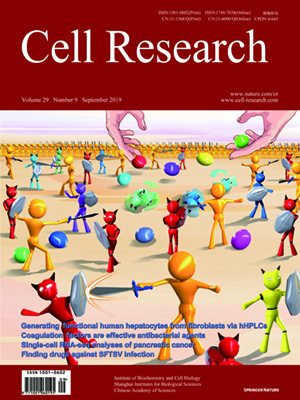
Volume 29, No 9, Sep 2019
ISSN: 1001-0602
EISSN: 1748-7838 2018
impact factor 17.848*
(Clarivate Analytics, 2019)
Volume 29 Issue 9, September 2019: 770-772
LETTERS TO THE EDITOR
Forkhead domain mutations in FOXA1 drive prostate cancer progression
Shuai Gao 1, Sujun Chen 2,3, Dong Han1, David Barrett1, Wanting Han 1, Musaddeque Ahmed3, Susan Patalano1, Jill A. Macoska1, Housheng Hansen He 2,3 and Changmeng Cai 1
1Center for Personalized Cancer Therapy, University of Massachusetts Boston, Boston, MA 02125, USA; 2Department of Medical Biophysics, University of Toronto, Toronto, ON, Canada and 3Princess Margaret Cancer Center/University Health Network, Toronto, ON M5G1L7,Canada
These authors contributed equally: Shuai Gao, Sujun Chen
Correspondence: Housheng Hansen He (hansenhe@uhnresearch.ca)or Changmeng Cai (changmeng.cai@umb.edu)
Dear Editor,
FOXA1 (Forkhead Box Protein A1) is a pioneer transcription factor (TF) that functions to loosen the compact chromatin structure to facilitate binding of other TFs such as estrogen receptor and androgen receptor (AR).1,2 AR is a nuclear receptor functioning as a ligand-dependent TF that plays a pivotal role in driving the initiation of prostate cancer (PCa) and the development of castration-resistant PCa (CRPC).3 The chromatin binding of AR is dependent on FOXA1, which interacts with DNA through its Forkhead DNA binding domain (FKHD). Recent studies on PCa patient samples revealed genetic mutations of FOXA1 in primary PCa (~4%) and the mutation frequency is increased in the high-risk racial groups and in more aggressive metastatic CRPC (~10%),4,5,6,7 suggesting that PCa with FOXA1 mutations may be more aggressive and resistant to current therapies. The majority of FOXA1 mutations (~60%-80%) are found in a hot spot region located at the Wing2 region of FKHD. Due to a lack of functional studies, it remains unclear how these mutations affect PCa progression and patient outcome.
https://doi.org/10.1038/s41422-019-0203-2
FULL TEXT | PDF
Browse 1326


